 |
|
By
Wikipedia,
the free encyclopedia,
http://en.wikipedia.org/wiki/Mil_Mi-8
The Mil Mi-8 (Russian Ми-8, NATO reporting name "Hip") is a medium twin-turbine transport helicopter that can also act as a gunship. The first prototype, the W-8, flew in 9 July 1961. It was powered by a single AI-24V engine. A second prototype, with two AI-24V engines, made its first flight on 17 September 1962. After a few changes it was introduced into the Soviet Air Force by 1967 as the Mi-8, and remains in production as of 2009.
The Mi-8 is the world's most-produced helicopter, and is used by over 50 countries. There are numerous variants, including the Mi-8T which is armed with rockets and anti-tank guided missiles, in addition to carrying twenty-four soldiers. The Mil Mi-17 export version is employed by around 20 countries; its equivalent in Russian service in the Mi-8M series. The naval Mil Mi-14 and attack Mil Mi-24 are also derived from the Mi-8.
Operational service
Use in former Yugoslavia
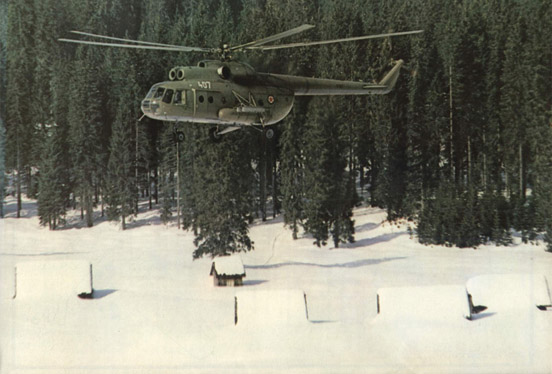 | |
Mi-8T helicopter of YuAF. |
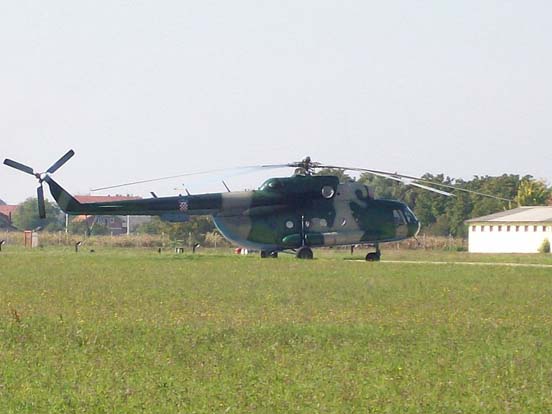 | |
Croatian Mil Mi-8MTV-1 |
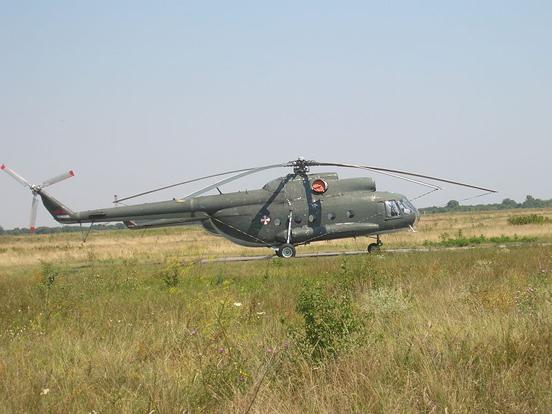 | |
Serbian Mi-8T cargo helicopter |
The Yugoslav Air Force bought 24 Mi-8T (Hip C) transport helicopters from May 1968 to May 1969 to equip two squadrons of the newly formed 119th transport regiment from Niš military airport, each squadron with 12 helicopters. Subsequently, from 1973 to the early 1980s, Yugoslavia purchased more Mi-8T helicopters to re-equip two squadrons of 111th regiment from Pleso military airport near Zagreb and the 790th squadron from Divulje military airport near Split, which was under the command of the Yugoslav Navy. In total, the Yugoslav Air Force received 92 Mi-8T transport helicopters from Soviet Union, known formally to the military as the HT-40, while local modification of several helicopters into electronic warfare variants produced the HT-40E. Some 40 helicopters were equipped for firefighting operations.
The Yugoslav Mi-8s' first combat operations were transport of army troops and federal police forces to border crossings in Slovenia on 27 June 1991. The members of Slovenian Territorial Defence fired Strela 2 MANPAD, and shot one helicopter down, killing all crew and passengers.
During combat in the winter of 1991 in Croatia and in the spring of 1992 in Bosnia and Herzegovina, Yugoslav People's Army used the Mi-8 fleet for evacutaion of injured personnel, transport of cargo and search and rescue of crews of aircraft forced down. As the most of flights were made behind the front, the Croatian forces were able to down one only helicopter, hit with small arms fire near Slavonski Brod on October 4th, 1991.
After Bosnian Serbs declared their state in the spring of 1992, some former Yugoslav Air Force Mi-8s continued service in new armed forces. The inventory of the 82nd mixed helicopter squadron of 92nd aviation brigade of Army of Republika Srpska contains 12 Mi-8T helicopters which continued in service until Operation Koridor. During that period, the Republika Srpska Air Force lost 3 Mi-8 helicopters to enemy fire. Three helicopters painted in a blue and white colour scheme flew in the first part of 56th helicopter squadron of Krajina Milicija, using Udbina military airport in Lika as their main base. The Republika Srpska Air Force continued to operate 9 helicopters, albeit suffering problems with maintenance and spare parts, until it was formally disbanded in 2006.
On the other side, Mi-8 helicopters were also used as main air transport. Croatian National Guard obtained their first on September 23rd, 1991, near Petrinja, when a Yugoslav Air Force Mi-8 made an emergency landing after being damaged by small-arms fire. A further 6 Mi-8T and 18 Mi-8MTV-1 helicopters were bought from ex-Warsaw Pact countries during the war, but only 16 of those survived the war. The remaining Mi-8Ts were retired from service in the Croatian Air Force after the war, while the Mi-8MTVs continued their service in 20th Transport Helicopter Squadron, and 28th Transport Helicopter Squadron. The latter has been re-equipped with new Mi-171Sh helicopters bought from Russia.
The Army of the Republic of Bosnia and Herzegovina secretly obtained Mi-8T, Mi-8MTV and Mi-17 helicopters from various sources. Bad aircrew training cost Muslim forces half of their helicopters. Two helicopters were shot down by Serbian air defences, one around Žepa, while one Mi-17 was shot down by 2K12 Kub M, killing the Bosnian Minister Irfan Ljubijankić, a few other politicians, and the helicopter's Ukrainian mercenary crew. A few Croatian Mi-8MTVs secretly supported Croatian Defence Council operations in Herceg Bosna. After the war, the Army of the Federation of Bosnia and Herzegovina operated the remaining 5 Mi-8MTV's and 1 Mi-8T in the Air Force and Air Defense Brigade of Armed Forces of Bosnia and Herzegovina.
Finally, the Macedonian Air Force bought 4 Mi-17V-1 in 1994 and 2 Mi-8MT helicopters in 2001 from the Ukraine. They fly in the Transport Helicopter Squadron (ex 301. Transport Helicopter Squadron). On the 12 January 2008, one crashed, killing all 8 passengers and 3 crew members. In May 2008 Macedonia acquired 4 additional Mi-171, purchased from Lithuania.
During the 1998-1999 Kosovo war, the Yugoslav Air Force used Mi-8s for transport of personnel and material to forces in otherwise-inaccessible mountain areas. Evacuation of injured personnel also occurred during the 1999 NATO bombing of Yugoslavia, flying at low altitude to avoid detection by NATO aircraft. Two Mi-17V helicopters which were secretly operated by the Unit for Special Operations post-1997 were also active during the Kosovan conflict. Afther the disbanding of the unit in 2003, the helicopters were transferred to Air Force.
Today the Serbian Air Force, successor of Yugoslav Air Force, operates between 6-8 Mi-8T and 2 Mi-17 helicopters in the 138th Mixed-Transport-Aviation Squadron of 204th Air Base and 119th Combined-Arms Helicopter Squadron (ex 199th regiment) of 98th Air Base.
Use in Finland
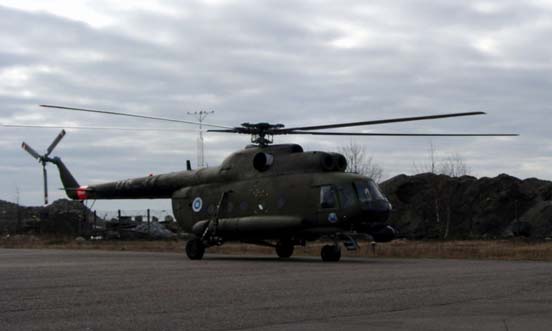 | |
Finnish Mi-8 in Hernesaari, Helsinki, in 2005 |
The Finnish Defence Forces and the Finnish Border Guard have been using Mi-8s since the 1970s. Six Mi-8Ts were first obtained, followed by a further two Mi-8Ts and two Mi-8Ps. Three of the helicopters were given to the Border Guard Wing. One of these was lost after sinking through the ice during a landing. This was soon replaced by a new Mi-8. After their Border Guard service, the helicopters were transferred to the civil register, but shortly thereafter to the Finnish Air Force. In 1997 it was decided that all helicopters, including the remaining five Mi-8Ts and two Mi-8Ps should be transferred to the Army Wing at Utti. Two Mi-8s are still in active service, since deliveries of NH90 helicopters have been delayed for more than 3 years due to delays in the type approval certificate. There's one Mi-8 at Utti that is not in active service and it's waiting for decision of will it be repaired or decommissioned (as of 2008). One Mi-8 is now exhibited at the Finnish Aviation Museum in Vantaa, and one is in Päijänne Tavastia Aviation Museum in Asikkala, near Lahti.
Use in Afghan
In Afghan. there are several civilian versions flying cargo contracts for the US Army.
Variants
Prototypes/experimental/low production rate variants
- V-8 (NATO - Hip-A)
- The original single-engined prototype.
- V-8A
- A twin-engined prototype, featuring TV2-117 turboshaft engines, the prototype underwent further modifications during its life.
- V-8AT
- Prototype of the Mi-8T utility version.
- Mi-8 (NATO - Hip-B)
- Twin-engined prototype.
- Mi-8TG
- Conversion to operate on LPG gas.
- Mi-18
- Prototype helicopter design, a modification of the existing Mil Mi-8. Two Mi-8s were extended by 0.9 meters (3 ft), the landing gear made retractable, and a sliding door added to the starboard side of the fuselage. The Mi-18s were used in the Soviet invasion of Afghanistan, and later used as static training airframes for pilots of the Mi-8/17.
Basic military transport/airframe variants
- Mi-8T (NATO - Hip-C)
- First mass production utility transport version, it can carry four UV-16-57 unguided rocket pods, (with S-5 rockets), on four weapons pylons on two sub-wings, and is armed with a side mounted PK machine gun.
- Mi-8TV
- Armed version of the Mi-8T.
- Mi-8TVK (NATO - Hip-E, aka Mi-8TB)
- Version used as a gunship or direct air support platform. Airframe modifications add 2x external hard points for a total of 6, and mount a flexible 12.7 mm (0.5-inch) KV-4 machine gun in the nose. Armament of 57 mm S-5 rockets, six UV-32-57 rocket pods, 551-lb (250-kg) bombs, or four AT-2 Swatter ATGMs.
- Mi-8TBK (NATO - Hip-F)
- Armed export version, fitted with six launch rails to carry and fire Malyutka missiles.
Command and electronic warfare variants
- Mi-8IV (NATO - Hip-G, for export - Mi-9)
- Airborne command post version characterized by antennas, and Doppler radar on tail boom (based on Mi-8T airframe).
- Mi-8PPA (NATO - Hip-K)
- Airborne jamming platform characterized by 6x “X”-shaped antennas on the aft fuselage. Built only for export.
- Mi-8PD
- Polish airborne command post version.
- Mi-8PS (NATO - Hip-D, aka Mi-8TPS)
- Radio relay and command post version.
- Mi-8SMV (NATO - Hip-J)
- Airborne jamming platform characterized by small boxes on the left side of the fuselage. Used for protection of ground attack aircraft against enemy air defenses.
- Mi-8VPK (NATO - Hip-D, aka Mi-8VZPU)
- Airborne communications platform with rectangular communication canisters mounted on weapons racks.
Other military variants
- Mi-8AV
- Minelaying version.
- Mi-8VT
- Mine-clearing version.
- Mi-8MB
- Military ambulance version.
- Mi-8R
- Reconnaissance version.
- Mi-8K
- Artillery observation, reconnaissance version.
- Mi-8PT
- Military staff transport version, fitted with improved radio equipment.
- Mi-8SKA
- Photo-reconnaissance version.
- Mi-8T(K)
- Photo-reconnaissance version.
- Mi-8TZ
- Fuel transport tanker version.
Civil variants
- Mi-8T (NATO - Hip-C)
- Civilian and military utility transport version, with accommodation for 24 passengers, fitted with tip-up seats along the cabin walls and circular cabin windows. The Mi-8T is powered by two 1,677-shp (1250-kW) Klimov TV2-117A turboshaft engines, giving the helicopter a maximum speed of 155mph (250km/h) at sea level.
- Mi-8P
- Civilian passenger transport version, with accommodation for between 28 and 32 passengers, fitted with square cabin windows, powered by two 1,700-hp (1268-kW) Klimov TV2-117A turboshaft engines.
- Mi-8S "Salon"
- Civilian VIP transport version, with accommodation for between 9 and 11 passengers, equipped with a galley and toilet.
- Mi-8MPS
- Search and rescue version (operated usually in Malaysia for Fire and Rescue Department services).
- Mi-8MA
- Polar exploration version for use in the Arctic.
- Mi-8MT
- Flying crane version.
- Mi-8AT
- Civilian transport version, fitted with two improved TV2-117AG turboshaft engines.
- Mi-8ATS
- Agricultural version, fitted with a hopper and spray bars.
- Mi-8TL
- Air accident investigation version.
- Mi-8TM
- Upgraded transport version, fitted with a weather radar.
- Mi-8TS
- Hot and high desert version.
- Mi-8VIP
- De luxe VIP transport version, with accommodation for between 7 and 9 passengers.
- Mi-8PA
- Remodeled version for Japanese regulation. Built only 1 in 1980, and used in Aero Asahi for heavy material transport at a mountainous. She retired at 1993, and exhbiting in museum.
Operators
Military Operators
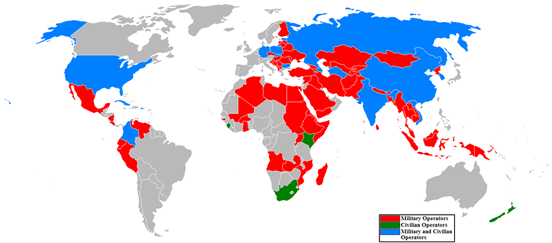 | |
Mi-8 and Mi-17 operators |
 | |
Polish Mi-8S |
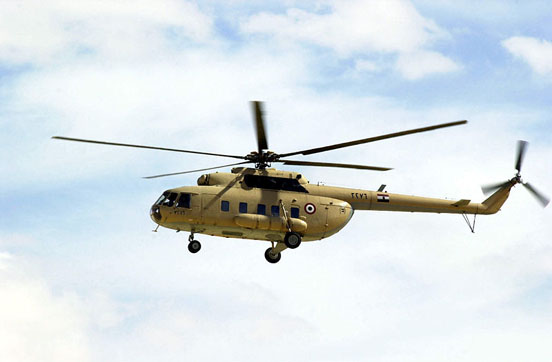 | |
An Egyptian Air Force Mil Mi-8 Hip helicopter flies over Range A as the Combined Live fire Exercise (CALFEX) is conducted near Mubarak Military City. |
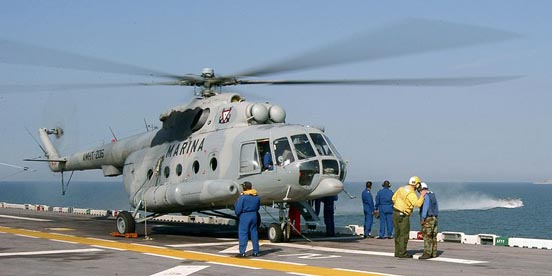 | |
A Mexican Navy Mi-8 helicopter stands by for passengers on the flight deck aboard the amphibious assault ship USS Bataan (LHD 5), off the coast of Mississippi. |
 Afghanistan Afghanistan- 65 have been acquired by the Afghan Air Force, with deliveries of 30 Mi-8 since 1971, and 35 Mi-17 since 1987.
 Albania Albania- At least 1 Mi-8T was acquired by the Albanian Air Force during the mid-1990s from Ukraine.
 Algeria Algeria Angola Angola Anguilla Anguilla Armenia Armenia- 13 in service with the Armenian Air Force.
 Azerbaijan Azerbaijan- 13 Mi-17s in service
 Turkey Turkey- 18 Mi-17s in service with the Jandarma
 Belarus Belarus Bangladesh Bangladesh- 43 Mi-17s and some Mi-8/Mi-8 MTVs in service
 Bhutan Bhutan- 7 Mi-8s in service
 Bosnia and Herzegovina Bosnia and Herzegovina- 3 Mi-8s in service
 Bulgaria Bulgaria- 18 Mi-8s in service
 Burkina Faso Burkina Faso- 5 Mi-8s in service
 Canada Canada- 6 Mi-8s leased for one year from Skylink Aviation
 Cambodia Cambodia- 6 Mi-8/17s in service
 China China- 250 Mi-8/17s in service
 Colombia Colombia- 10 Mi-17 in service
 Croatia Croatia- 15 Mi-8MTVs in service, 10 new Mi-171Sh entered service in 2007
 Cuba Cuba Czech Republic Czech Republic- 40 Mi-8/17s in service
 Djibouti Djibouti- 3 Mi-8s in service
 East Germany East Germany- East German Air Force, Volksmarine
 Ecuador Ecuador Egypt Egypt- Egyptian Air Force 42 Mi-8s in service
 Egypt Egypt- Unit 777 16 Mi-8's in service
 Estonia Estonia- 1 in service with the Border Guard Aviation Corps till late 2009
 Ethiopia Ethiopia- 12 Mi-8s in service
 Finland Finland
 Germany Germany- Ex-Eastern Germany helicopters
 Georgia Georgia- 18 Mi-8T/MTV helicopters in service
 Ghana Ghana- Ghana Air Force
 Guinea-Bissau Guinea-Bissau- 1 Mi-8T in service
 Hungary Hungary- 23 Mil Mi-8 helicopters in service
 Israel Israel- 1 Captured Egypt helicopter
 India India- 134 Mi-8s in service of Indian Air Force
 Indonesia Indonesia- 10 Mi-17 was in order in 2006
 Iran Iran- 52 Mi-8/17s in service
 Iraq Iraq- Iraqi Air Force
 Kazakhstan Kazakhstan Kenya Kenya- Used by the police for patrols acquired second hand in 2001
 Kyrgyzstan Kyrgyzstan- 8 Mi-8s are in service of Iraq Air Force
 Laos Laos Latvia Latvia- 4 Mi-8/17MTV in service
 Libya Libya Lithuania Lithuania- 5 Mi-8MTV in service
 Macedonia Macedonia- 9 in service
 Madagascar Madagascar Malaysia Malaysia Montenegro Montenegro- 3 in service, 2 inoperable condition
 Maldives Maldives- 3 Mi-8s were used by Hummingbird Helicopters in the 1990s. 2 were operated by Seagull Helicopters.
 Mali Mali Mexico Mexico Moldova Moldova- 8 in service
 Mongolia Mongolia- Mongolian Air Force
 Mozambique Mozambique Myanmar Myanmar- 12 in service
 Nepal Nepal Nicaragua Nicaragua North Korea North Korea Pakistan Pakistan Peru Peru- 14 Mi-17s in service
 Poland Poland- Polish Air Force
 Romania Romania Russia Russia- Russian Air Force, Russian Naval Aviation and Russian Army
 Senegal Senegal Serbia Serbia- 15 Mi-8's and 2 Mi-17's in service
 Sri Lanka Sri Lanka Slovakia Slovakia Somalia Somalia Soviet Union Soviet Union- Soviet Air Force, Soviet Army Aviation, Soviet Naval Aviation and USSR Border Troops. Passed on to successor states
 Sudan Sudan Syria Syria- Syrian Air Force
 Tajikistan Tajikistan Turkmenistan Turkmenistan Uganda Uganda Ukraine Ukraine- Used by the Ukrainian Airmobile Forces, Ukrainian Air Force, Ukrainian Naval Aviation and Ukrainian Ground Forces
 Uzbekistan Uzbekistan United Kingdom United Kingdom- 2 Mi-8s in service with Defence Evaluation and Research Agency
 United States United States- Used by the 6th Special Operations Squadron for training
 Vietnam Vietnam Venezuela Venezuela- (Mi-17)
 Yemen Yemen Yugoslavia Yugoslavia- Operated about 93 Mi-8T helicopters, passed on to successor states
 Zambia Zambia
- On October 15, 2006, India agreed to acquire 80 Mi-17 helicopters from Russia in a deal worth approximately US$662 million dollars.
Civil Operators
 Azerbaijan Azerbaijan- Azerbaijan Airlines (Mi-8T)
 Canada Canada- Skylink Aviation
 Colombia Colombia
- Vertical de Aviacion
- Helistar
- Heliandes
- Helicol
 Cuba Cuba- Aerogaviota
 Estonia Estonia- Border Guard, soon replaced by AW139
 Germany Germany- German Police
 India India- Jagson Airlines
 Mongolia Mongolia- Mongolyn Alt (MAK) Corp (Mi-8T)
 New Zealand New Zealand- Heli Harvest Ltd. (2x Mi-8MTV-1) based in Taupo
 Soviet Union Soviet Union- Aeroflot
 Russia Russia
 Sierra Leone Sierra Leone
 Slovakia Slovakia- Air Transport Europe
 South Africa South Africa- UTAir S.A.
 Turkmenistan Turkmenistan- Turkmenistan Airlines
 United States United States- Blackwater USA
 Vietnam Vietnam- VASCO - Vietnam Air Services
Specifications (Mi-8T 'Hip C')Data from Jane's All The World's Aircraft 1992-93
General characteristics
- Crew: 3 (pilot, copilot, flight engineer)
- Capacity:
- 24 passengers or
- 12 stretchers and seat for 1 medical attendant or
- 3,000 kg (6,600 lb) on internal/external hardpoints
- Length: 18.17 m (59 ft 7 in)
- Rotor diameter: 21.29 m (69 ft 10 in)
- Height: 5.65 m (18 ft 6 in)
- Disc area: 356 m² (3,832 ft²)
- Empty weight: 7,260 kg (16,007 lb)
- Loaded weight: 11,100 kg (24,470 lb)
- Max takeoff weight: 12,000 kg (26,455 lb)
- Powerplant: 2× Klimov TV3-117Mt turboshafts, 1,454 kW (1,950 shp) each
- Fuel max total capacity: 3,700 l (977 US gal)
Performance
Armament
See also
Related development
Comparable aircraft
The initial version of this article was based on material from aviation.ru. It has been released under the GFDL by the copyright holder.
External links
Text from Wikipedia is available under the Creative Commons Attribution/Share-Alike License; additional terms may apply.
Published in July 2009.
Click here to read more articles related to aviation and space!
|
 |



